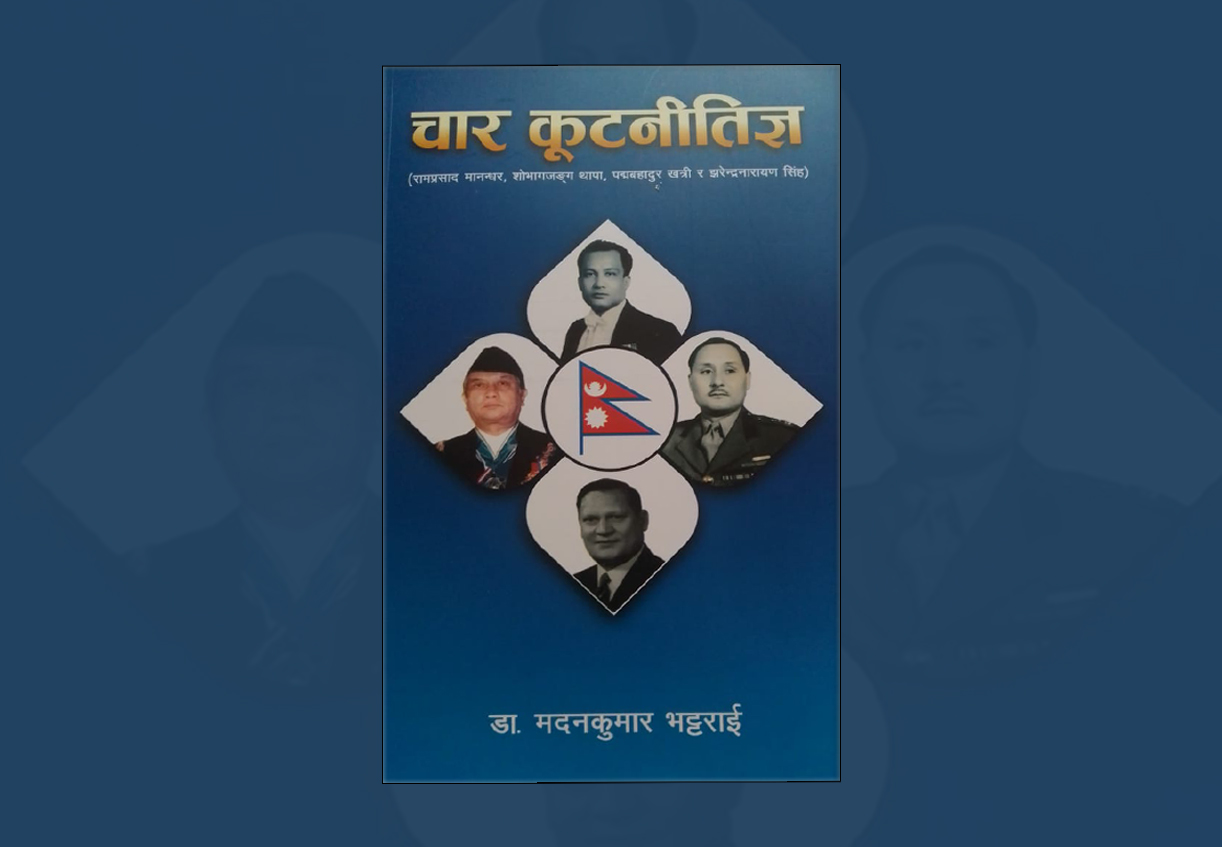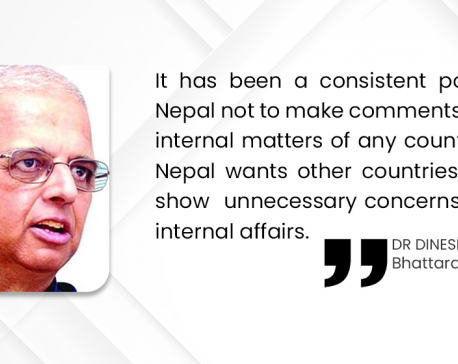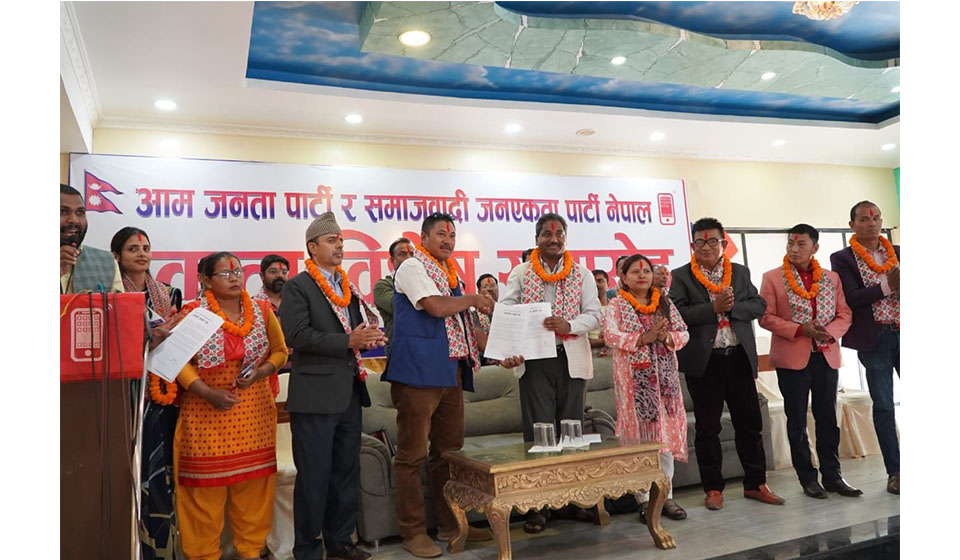
OR
Book Review
The Four Diplomats: Unraveling Nepal's foreign policy pioneers
Published On: July 24, 2023 03:30 PM NPT By: Gopal Bahadur Thapa

Dr Madan Kumar Bhattarai, a former Foreign Secretary and ambassador to Germany and Japan, needs no introduction. He is already a renowned diplomat. Now, he has been equally active in writing biographies of people who made significant contributions to construct and consolidate Nepal's foreign policy during its formative periods. His passion for the study of family ancestries and histories, called genealogy, is also well-known. This book, where he has painstakingly delved into a wealth of unknown but illuminating information about four former diplomats and foreign secretaries, is proof itself. One wonders how much effort he must have put into collecting, collating, and presenting information in as reliable a manner as possible to bring about this book. With this new addition to his literary repertoire, Dr. Bhattarai has immensely contributed to enhancing the knowledge of readers interested in knowing how the early history of the Foreign Ministry was shaped and honed by those four diplomats.
The book has three components. It seeks to trace the family antecedents of all four diplomats. Then, he has provided their academic backgrounds. The third aspect covers their performances as professionals. Information about their family backgrounds makes for quite an interesting read as it takes one to an unknown territory. Among the four, the academic performance of Ram Prasad Manandhar is incredibly astounding. Securing first division all the way from high school to university education is by no means a small feat. I stand corrected if I am wrong, but the late Narendra Bikram Shah also achieved that feat!
Dr. Bhattarai has succinctly depicted the tumultuous periods during which these four people served as foreign secretaries. This book offers a wealth of information about the post-1950s world that was slowly recovering from the aftermath of WW2. Nepal had recently thrown off the century-plus-old hereditary Rana rule. This was also a period that saw the emergence of newly independent countries in many Asian, African, and Latin American nations, breaking free from the yoke of colonialism. There was enthusiasm and initial euphoria of breathing in the fresh air of freedom. Nepal was no exception. A new democratic political order had been put in place, replacing the old one. However, consolidating the new democratic system and conducting international relations to ensure political and administrative stability were big challenges. The choice of the four, each one distinct from the other, appears quite strange but pragmatic. Late Ram Prasad Manandhar was exceptionally talented. The other two brought in tact and experience from their military background. The book, as the author himself has admitted, falls short on analytical insights into the diplomatic performances of all four, due to the absence of their memoirs. One wonders why and how the talent of late Manandhar was not fully utilized in the formulation and execution of foreign policy. He was made foreign secretary for a very brief period of time. Dr. Bhattarai has not offered any clues either. Reading between the lines of his academic and family background, Manandhar appears to be more of a diplomat of linear thinking, as are most talented intellectuals. He seems to lack tact in proportion to his talent and appears to enjoy being engaged in academic activities. The reason for his early retirement from active government service seems enigmatic. It was a pity the government never thought of taking advantage of his vast knowledge and brilliant academic career!
The other three seem to be diplomats more of tact than talent. In diplomacy, as well as in politics, a tactful person can endure much longer and become more successful than someone with talent. Padam Bahadur Khatri, a man of few words, not much known for his oratory skills and articulation ability, is an example of how a tactful person who knows how to read the situation and move accordingly can succeed in diplomacy. That is why he could go the distance. Jharendra Narayan Singh had his own unique qualities. He appears to be a diplomat with an aristocratic touch, who preferred to look suave and urbane, with a keen taste for sartorial elegance.
In between, Dr. Bhattarai has added his own perspectives to the book about the contemporary world and also about Nepal-India relations of the time. According to him, India preferred to call it a special relationship, although Nepal has never acknowledged, let alone recognized, this kind of relationship with India, as Dr. Bhattarai hints at. He even touches upon BP and Nehru's personal relations, which he says were not always easy. The book offers a comprehensive picture of the historical Bandung Conference of Afro-Asian countries held in Indonesia. One cannot agree more that the Bandung Conference offered the first-ever opportunity for Nepal to peep into the international world and make its presence felt among the international community. The Bandung Conference gave impetus to the famous five principles of peaceful co-existence, which later were further refined and developed into the Non-aligned Movement. The four diplomats have, in their own ways, served as international eyes to help bring Nepal into international focus.
The book only offers a short account of the personal, academic, and professional backgrounds of the four diplomats. The challenges Nepal faced in the international arena, what those challenges were, and how these four diplomats fended them off are not to be found in the book. The looming shadow of the Cold War and many countries forming different defense pacts like WARSAW, NATO, SENTO, thereby dividing the world rapidly into different security alliances, what role did the four diplomats play in tackling those challenges is not there. Perhaps the writer did not find information on that. If only that information were included, the book would have been even more interesting and useful for readers.
Similarly, the book should have made mention of the contribution of late King Mahendra, the architect of modern foreign policy of Nepal, the one who took a firm decision to steer Nepal towards the course of non-aligned foreign policy as an eyesore. Even late Yadu Nath Khanal in one of his books has lauded late King Mahendra as one who, by diversifying the foreign policy of Nepal, offered a vantage point for Nepal to look out into the contemporary world. There is no denying that the diplomatic personalities of the four diplomats were shaped and honed by none other than late King Mahendra!
The creation of anything is always beautiful. But it is not a cakewalk either. It is more so when writing a biography about persons who are no more. Gathering information about them takes a lot of strenuous effort, and making it more authentic is even more difficult. Dr. Bhattarai deserves our appreciation for bringing into prominence the four diplomats who helped, in their respective ways, lay the foundation stone of our foreign policy. The book is an invaluable contribution to enhancing the understanding of our younger generations, who were otherwise unknown to these great people. With additional information materials, including the text of speeches made at the Bandung Conference, relevant photos and other reference materials given at the end of the book, it's like icing on the cake.
You May Like This

Missing principle in Nepal’s foreign policy?
It has been a consistent policy of Nepal not to make comments on the internal matters of any country and... Read More...

Intelligence and Nepal’s foreign policy
Continued neglect of intelligence in foreign policy formulating process has helped foreign intrigues to, what BP Koirala warned in 1976,... Read More...




Just In
- Sunkoshi-Marin Diversion Project’s tunnel construction nears completion, breakthrough scheduled for May 8
- Govt tightens security arrangement for Third Investment Summit 2024
- Pesticide residue found in vegetables in Nepalgunj
- Aam Janata Party and Samajwadi Jana Ekata Party merge
- 1,600 participants confirmed for Nepal Investment Summit
- Ilam-2 by-elections held peacefully, vote count likely to start tonight
- NEA schedules five-day power cut across Kathmandu Valley for underground cable installation
- Hundreds of passengers including foreign tourists in distress as poor visibility halts flights to and from PRIA








-1200x560-wm_20240427144118.jpg)




Leave A Comment